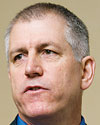Timing is everything. With the nation buzzing about the economic stimulus package—considered extremely likely to include billions of dollars for infrastructure—the American Society of Civil Engineers brought 80-plus experts together for a critical infrastructure summit. The meeting was part of ASCE’s long-range planning effort, but attendees found themselves discussing the next few months as well as the decades to come.
Blaine Leonard, ASCE president-elect and research program manager of Utah Dept. of Transportation, told attendees at the Dec. 8-10, Landsdowne, Va., session that their mission was to begin to identify how organizations that work with multifunded, multijurisdictional, long-term construction and sustainment projects can successfully accomplish their tasks. The group was presented with four guiding principles, identified by a task committee, to ensure the nation’s critical infrastructure systems are “resilient and sustainable throughout their life cycle” and to manage the risks to them. ASCE defines “critical infrastructure” as systems and facilities so vital that disruption would threaten the security, economy, health, safety or welfare of the public.

LAND
Richard D. Land, chief engineer and deputy director of project delivery for California Dept. of Transportation, described his agency’s continuing efforts to maintain and upgrade critical systems in the face of dynamic conditions as infrastructure ages and population increases. Four major earthquakes since 1971 presented a moving target, but 98% of the state system and 70% of the local system have been strengthened “to prevent collapse and loss of life,” Land said. Emerging issues that continue to make Caltrans’ goals dynamic are “stormwater mitigation and climate-change adaptation strategy.”
Teams of professionals used this and other briefings to brainstorm ideas about how to implement the guiding principles. For example, one group called for the creation of a National Infrastructure Policy Act. Attendees clearly wanted their work to get out to the states in time to be used as officials make decisions about the infrastructure spending coming in the stimulus package. Robert Prieto, senior vice president of Fluor Corp., urged “coordinated action” by industry groups, suggesting the Infrastructure Security Partnership as a model.

MANOUS
Joe D. Manous, task committee chair and member of the Institute for Water Resources at the U.S. Army Corps of Engineers, said ASCE does plan to reach out to other groups. He said the ideas from the summit will be used to produce a “guidance document for decision makers of infrastructure.”
| The stewards of infrastructure should: |
|---|
| Quantify, communicate and manage risk. |
| Employ an integrated systems approach. |
| Exercise sound leadership, management and stewardship in decision-making processes. |
| Adapt critical infrastructure in response to dynamic conditions. |
| Source: AMERICAN SOCIETY OF CIVIL ENGINEERS |






